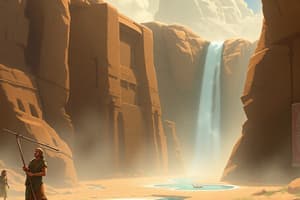Podcast
Questions and Answers
How did Sir Mortimer Wheeler define archaeology?
How did Sir Mortimer Wheeler define archaeology?
Archaeology is the study of human history and prehistory through the excavation of sites and the analysis of artifacts.
What is prehistory?
What is prehistory?
Prehistory refers to the period before written records, from the earliest stone tools to the advent of writing systems.
According to Lewis Binford, what is the aim of archaeology?
According to Lewis Binford, what is the aim of archaeology?
Archaeology aims to reconstruct cultural systems and understand the processes that led to their transformation.
What aspect of archaeology did Ian Hodder emphasize?
What aspect of archaeology did Ian Hodder emphasize?
Why is prehistory considered crucial in human history?
Why is prehistory considered crucial in human history?
How did V. Gordon Childe view the study of prehistory?
How did V. Gordon Childe view the study of prehistory?
What is the relationship between prehistoric archaeology and anthropology?
What is the relationship between prehistoric archaeology and anthropology?
What tools do archaeologists analyze to gain insights into early human life?
What tools do archaeologists analyze to gain insights into early human life?
How do archaeological findings contribute to understanding human evolution?
How do archaeological findings contribute to understanding human evolution?
What role do anthropological theories play in relation to archaeological findings?
What role do anthropological theories play in relation to archaeological findings?
Why is collaboration between archaeology and anthropology considered essential?
Why is collaboration between archaeology and anthropology considered essential?
Who emphasized the importance of integrating archaeological data with anthropological theories?
Who emphasized the importance of integrating archaeological data with anthropological theories?
What is a significant influence of Claude Lévi-Strauss on archaeological interpretation?
What is a significant influence of Claude Lévi-Strauss on archaeological interpretation?
How do archaeological findings and anthropological theories complement each other?
How do archaeological findings and anthropological theories complement each other?
What specific geographic area is being studied for geomorphologic features in the context of the Pleistocene and Holocene?
What specific geographic area is being studied for geomorphologic features in the context of the Pleistocene and Holocene?
What are the key outcomes of combining archaeological findings with anthropological interpretations?
What are the key outcomes of combining archaeological findings with anthropological interpretations?
Flashcards are hidden until you start studying
Study Notes
Archaeology Overview
- Archaeology studies human history and prehistory through analysis of material remains, emphasizing a scientific approach.
- Sir Mortimer Wheeler defined archaeology as discovering insights from excavations and artifacts, rather than merely finding objects.
- Lewis Binford highlighted that archaeology aims to reconstruct cultural systems and understand their transformations.
- Ian Hodder stressed the significance of interpreting symbolic meanings within material remains.
Prehistory Importance
- Prehistory spans from the earliest stone tool use (around 3.3 million years ago) to the development of writing (around 5,000 years ago).
- V. Gordon Childe emphasized prehistory's role in illuminating human evolution and the progression towards civilization, noting erratic societal advancements.
- Key archaeological methods include analyzing artifacts, fossils, and cave paintings, which offer insights into early human life and cultural practices.
Relationship Between Prehistoric Archaeology and Anthropology
- Prehistoric archaeology and anthropology mutually enhance the understanding of human history and culture.
- Archaeological findings provide tangible evidence, vital for understanding human evolution and cultural contexts, such as East Africa's stone tools and fossil discoveries.
- Anthropology offers interpretive frameworks for archaeological findings, addressing social organization and the symbolic meanings of artifacts.
Interdisciplinary Collaboration
- Lewis R. Binford advocated for collaboration between archaeology and anthropology to decode the complexities of prehistoric societies.
- Claude Lévi-Strauss's theories have influenced the interpretation of archaeological findings, focusing on cultural patterns and behavior.
- Scholars like Grahame Clark have promoted integrating archaeological data with anthropological theories for a comprehensive view of prehistory.
Conclusion
- The interplay between prehistoric archaeology and anthropology creates a richer understanding of humanity's ancient past.
- This multidisciplinary approach is essential in exploring the evolutionary and cultural processes that shaped human history.
Study Objective
- The objective focuses on studying the Pleistocene and Holocene geomorphologic features of the Dulung river basin in West Bengal, specifically between Chilkigarh palace and Uttarasol village.
Studying That Suits You
Use AI to generate personalized quizzes and flashcards to suit your learning preferences.




